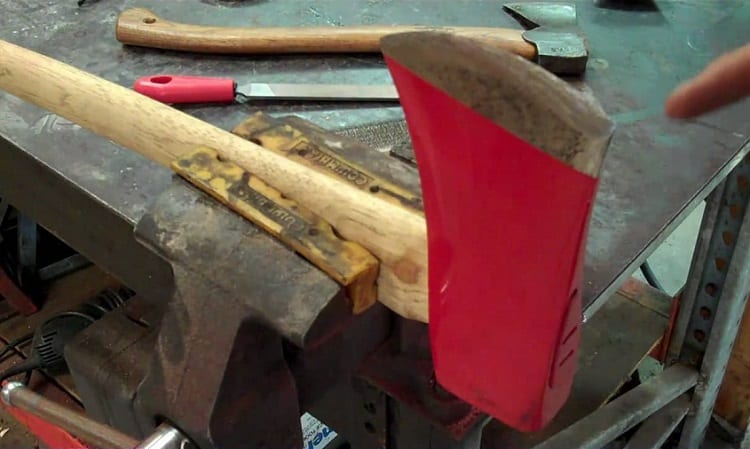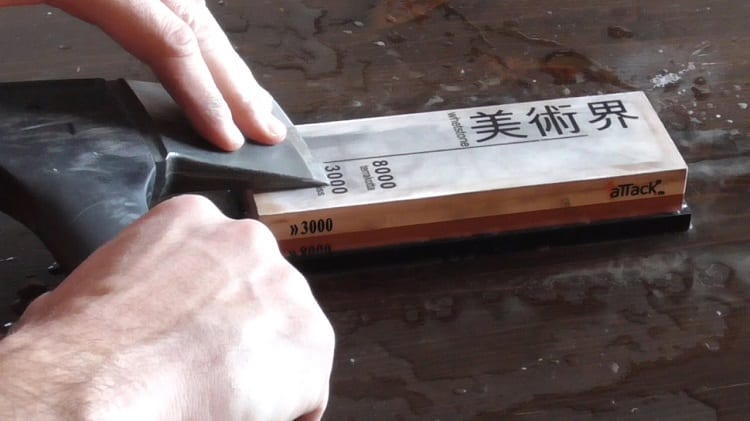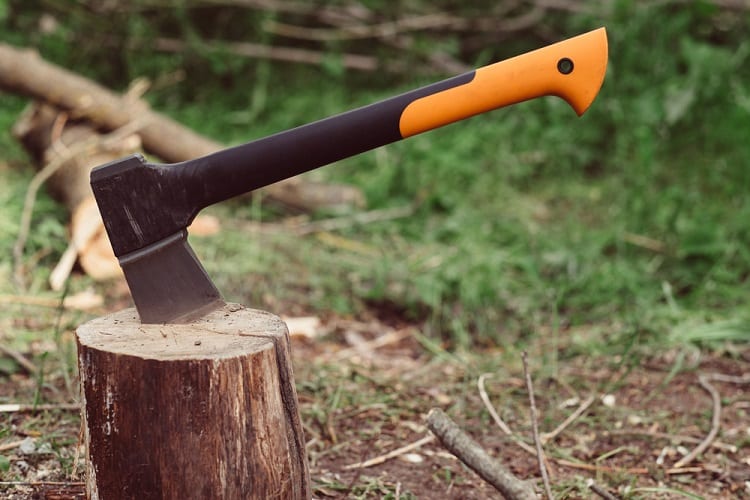You’re preparing for the worst, and one of the most beneficial tools you can possibly have at your disposal is a survival hatchet.
Utility, self-defense, you name it, your survival hatchet can fill the role. I would rather have my hatchet hanging from my waist in more scenarios than anything else, but if it’s dull, it’s basically just a blunt chunk of metal on a stick.
Maintenance is everything here. Don’t know how to sharpen a hatchet?
That’s alright – I’m going to break it down, step by step, method by method right now.
Is Sharpening a Hatchet Any Different From Sharpening Knives?

Yes. When you sharpen knives, you’re following a specific bevel. Some knives (notably, Japanese knives) will have a one-way 15° bevel, meaning you leave one side flat and only sharpen the other side of the knife.
You’ll use one of the three methods we discuss in this post to sharpen your axe: whetstones, files, and grinding tools (assorted).
With kitchen knives, you have more options available, such as a knife sharpener that also helps straighten out the metal at the same time. It’s easier to sharpen a knife than a hatchet.
Kitchen knives are also sharpened when they’re already clean, but most of the time, we don’t think about removing the grit and grime from our hatchets before sharpening. This is a step that’s often overlooked: clean your axe before you try to sharpen it.
What Types of Sharpening Methods Can You Use?

There are three in total that I would use. Whetstones, files, and an assortment of grinding tools that may or may not fit for your specific axe. Let’s go over all of them.
Whetstones
Whetstones take a lot of the work out for you. There are mechanical stones, which are pedal-powered and allow you to speed through this process. There are also manual stones, which we commonly see in cutlery sharpening.
Both are applicable. However, a pedal-powered full-weight whetstone is going to cost you a nice chunk of change. Unless you plan on becoming a modern blacksmith, these are usually too expensive and inconvenient for most of us.
Whetstones come with different grit ratings, much like sandpaper. Under 1,000 grit will help you break down broken edges of knives and even things out, although they are hard to work with.
Between 1,000 and 3,000 grit will help you refine a dull axe head and bring it to its former glory. This is generally enough for hatchet use.
However, 4,000 to 8,000+ grit is used in ultra-fine, low-angle cutlery, and would make your hatchet a force to be reckoned with. I don’t recommend using these, though, since they will make the edge of your axe much easier to bend and potentially snap.
Ultra high grit whetstones like this are better used in cutlery, which has less harsh applications than splitting logs or cutting down trees.
Files
Plain and simple, a file works like a metal-backed whetstone. You lay your hatchet down on a flat surface, hold it in place, and run the file down the edge.
This process can take some time, but it also lets you appreciate just how much goes into hatchet maintenance. I would keep a small one of these in a bug out bag so you can sharpen your hatchet on the move, or keep your knives razor sharp as well.
Grinding Tools
Grinding tools is just an ambiguous category for anything that isn’t a file or whetstone. You can have sharpening pucks, manual hatchet/knife sharpeners (smaller versions of electric knife sharpeners found in kitchens), and so on.
This also includes specific sharpeners that are manual, but are also designed just for hatchets and machetes. If you look up enough small grinding tools, you’ll find plenty of compact, easy to carry grinding tools that can fit into various EDC packs and bug out bags.
How to Keep a Hatchet Sharper for Longer

Carbon coat the edge of your hatchet. It’s a chore, but it can be done. This is a volatile process, and one that I cannot advise you on here, but if you use your knives often, carbon coating will protect them.
Depending on the grade of steel you’re using, you can also consider a chromium coating. This requires more equipment, but chromium-dipping a blade prevents rust entirely, and can keep that sharp edge on it for a very long time.
Make sure it’s sharpened and stored in a protective case as well. Nylon and leather cases do a wonderful job at protecting your hatchet edges.
What Types of Materials are Best for Hatchets?
Most hatchets made today are made out of medium-carbon steel. Carbon helps keep the edge from dulling when not in use, but it also keeps a sharper edge even through use.
There are many steel grades. You have 301, which is used in mechanical work, 316, which is used in food-safe surfaces and surgical gear, and the list goes on and on. You can find a full list of all steel grades here.
Typically, you want to find 440 and above because it holds a better edge to it. These are commonly used in cutlery, but can also be applied to axe manufacturing as well. The higher the grade of steel, the harder it is, and the longer it will last.
Keep it Sharp, Just Like You
Keep it sharp, keep it useful, and make sure that in any situation, you have the means to quickly and effectively make shelter or gather firewood with it.
Truth be told, your survival hatchet is going to serve a lot more purpose than just cutting down trees and splitting logs. You can skin fish, forage, and sharpen knives with your axe.
Your survival axe is one of the most powerful tools in your prepper arsenal, so make sure it’s kept close by and with a razor’s edge.


[lasso rel="emergency-preparedness-more-a-manual-on-food-storage-and-survival-2nd-edition-revised-and-updated" id="35334"]